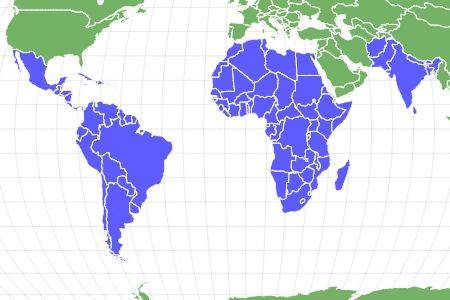Caecilian
Apoda
Some species' babies use their hooked or scraper-like teeth to peel off and eat their mother's skin
Advertisement
Caecilian Scientific Classification
- Kingdom
- Animalia
- Phylum
- Chordata
- Class
- Amphibia
- Order
- Gymnophiona
- Family
- Caecilidae
- Genus
- Caecilia Linnaeus
- Scientific Name
- Apoda
Read our Complete Guide to Classification of Animals.
Caecilian Conservation Status
Caecilian Facts
- Prey
- termites, earthworms, insects and other invertebrates
- Fun Fact
- Some species' babies use their hooked or scraper-like teeth to peel off and eat their mother's skin
- Biggest Threat
- habitat loss
- Most Distinctive Feature
- Hooked teeth in some species babies for peeling and eating mother's skin
- Litter Size
- two to 60
- Habitat
- wet and tropical
- Predators
- snakes, chickens, pigs, tenrecs, fish
- Diet
- Carnivore
- Type
- amphibian
- Common Name
- Caecilians
- Number Of Species
- 192
- Location
- South America, South Asia, Southeast Asia, Africa, Central America, Seychelles
View all of the Caecilian images!
“There are 192 species around the world, ranging in size from 3 inches to 5 feet long!”

Caecilians are smooth-skinned, limbless amphibians that range in size from three inches to five feet long. Some of the 192 species native to wet and tropical regions look like earthworms and other larger species look like snakes. Some have short tails while others have none at all. Although the amphibians are not native to the Americas beyond southern Mexico, one was found alive in a canal in South Florida in 2021. It was most likely transported to the state and illegally introduced as part of the wildlife trade. Otherwise, different species are found in South America, South Asia, Southeast Asia, Africa, India, Central America, and Seychelles. Most species live underground, burrowing where they do not need to hear or see and thus have no visible ears and only tiny or hidden eyes beneath their skin.
5 Incredible Caecilian Facts!
- Some have eyes beneath their skin while others have no eyes at all
- The only amphibians with tentacles
- The many different species make up a rainbow of colors
- Their hard skulls with pointy snouts enable them to burrow underground
- Babies peel off and eat their mother’s skin
Scientific Name
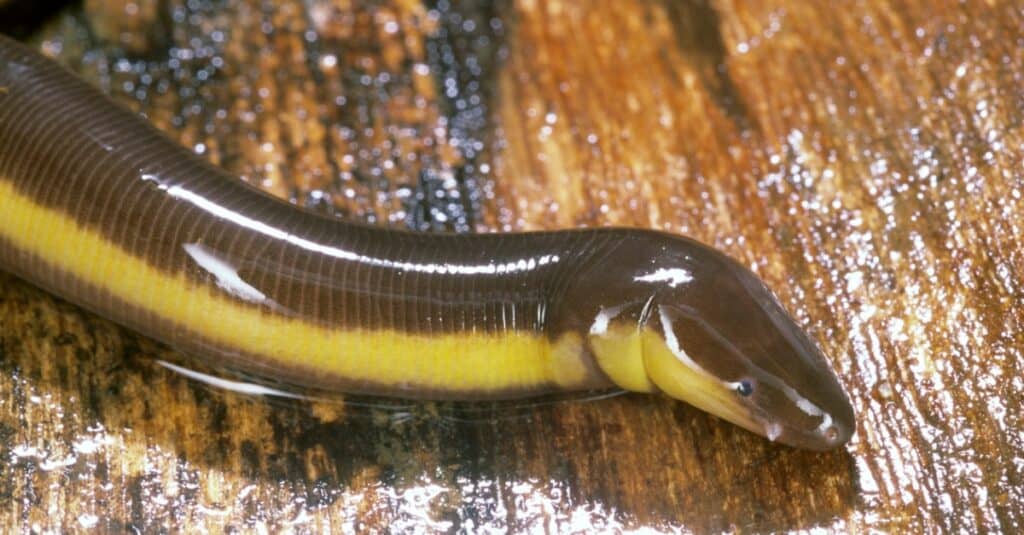
The name Caecilian comes from the latin word for “blind ones.”
©RealityImages/Shutterstock.com
These amphibians get their name from the Latin word that means blind, caecus. All modern and extinct species fall under the scientific name and order Gymnophiona. But there is still much debate among scientists about this name with many claiming the creatures should fall under the scientific name Apoda, meaning “without feet.” Only nine families and under 200 species were known to exist until after 2011 when a 10th family called Chikilidae was discovered.
Families of caecilians include:
- Rhinatrematidae
- Ichthyophiidae
- Scolecomorphidae
- Herpelidae
- Chikilidae
- Caeciliidae
- Typhlonectidae
- Indotyphlidae
- Siphonopidae
- Dermophiidae
Appearance & Behavior
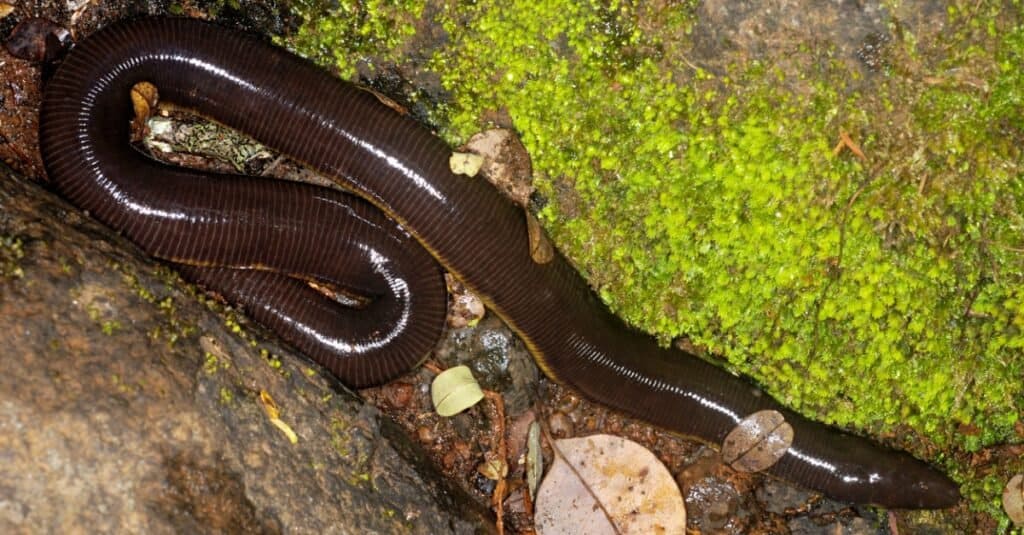
Caecilians have no arms or legs, and thus greatly resemble worms and snakes despite not being related to either.
©RealityImages/Shutterstock.com
Caecilians have no limbs and look much like worms or snakes, depending on the species size. Their size ranges from the smallest at three inches to the biggest at almost five feet long. They either have a short tail or none at all. Their slippery smooth skin ranges in color according to species, as well. Most are brown, gray, black, orange, or yellow, but some are more colorful.
Their skin covers calcite scales except for the species of the Scolecomorphidae and Typhlonectidae families. The Typhlonectes compressicauda of the Typhlonectidae family is the only exception to that rule with scales on the lower region of its body. Caecilians appear segmented because of ring-shaped folds appearing on their bodies. They also have glands in their skin that secretes toxins to ward off predators. Some are believed to have venomous bites like snakes, too. They have many sharp teeth that work like fangs to help them catch their prey and swallow it whole.
One of the most obvious traits of caecilians is their lack of eyes or the presence of only gray eye-like dots beneath their skin. They only can distinguish between dark and light and cannot otherwise see. Because they spend most of their time burrowing underground, they do not need vision.
Other adaptations for their burrowing lifestyle include a hard skull with a pointed snout and recessed mouth that enable them to force through dirt or mud more easily. The worm-like creatures also have strong muscles able to push through the ground. They can swim in water like an eel but must come to the surface to breathe. Some large species are aquatic, having a fin along the rear of their bodies.
All caecilians have two tentacles located above their nostrils and beneath their eyes. These are used to sense their environment in combination with the nasal sense of smell. They are the only amphibians with tentacles. Although most have internal ears hidden under their skin, scientists believe they may be able to sense vibrations. Species in the family Scolecomorphidae are the only amphibians that do not have any parts of the middle ear.
Except for one species, all caecilians have lungs. But they can also use their skin to absorb oxygen. Like snakes, many species have one lung that is smaller than the other because of their body shape.
Scientists know little about how these creatures live, their needs, or their temperament. It is not clear how they relate to each other or whether they live exclusively solitary lives.
Habitat
Of the hundreds of species of caecilians, most live underground where they burrow, have their young, and hunt for prey. Some venture into shallow streams of their mostly wet and tropical habitats. They are native to Central America, South America, South Africa, Central Africa, South Asia, and Southeastern Asia. People rarely see them in the wild because they live underground. But one species from Ecuador, the giant Caecilia pachynema, comes to the surface during rainstorms and at night. Some can hold their breath underwater for up to 30 minutes before returning to the surface for air.
Predators & Threats
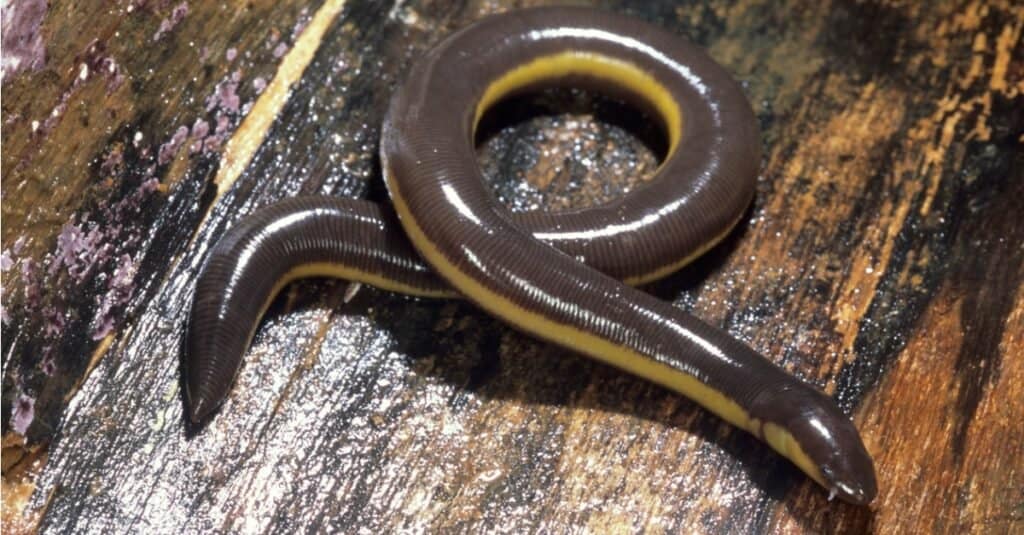
Caecilians are the only amphibians that possess two jaw muscles.
©iStock.com/ePhotocorp
Caecilians use their rows of sharp fangs to capture their prey. They have been observed clamping down onto earthworms and rolling like a rolling pin in the dirt underground to stun and drag the worm into their lair. They swallow their prey whole like a python instead of chewing the food up into bits. Researchers believe that some species have venom glands behind some teeth like rattlesnakes. This may also help them subdue their prey. They also are the only amphibians to have two sets of jaw muscles, making their jaws and mouths very strong.
What does the caecilian eat?
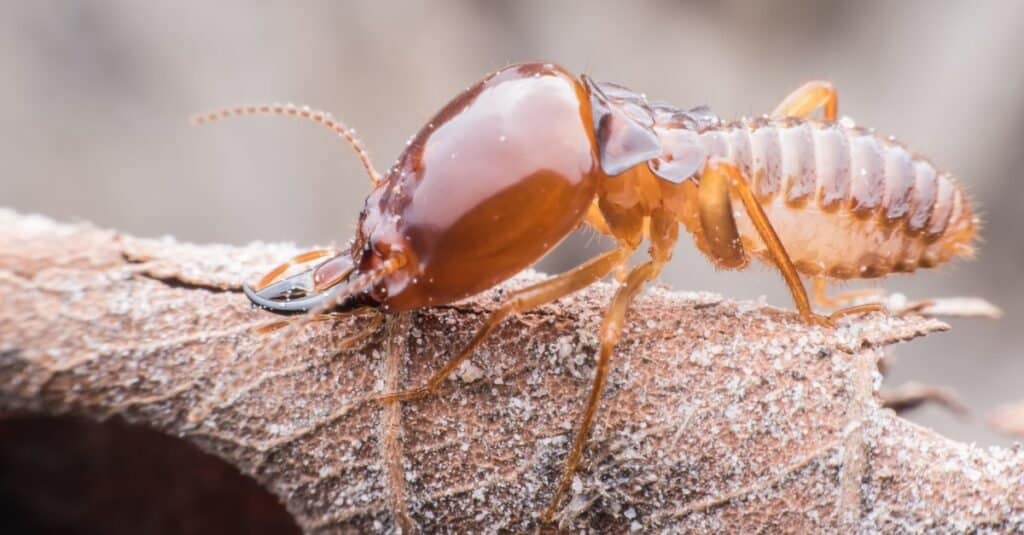
Termites are one of the caecilian’s favorite snacks.
©PK289/Shutterstock.com
Scientists do not yet know what most caecilians eat. But they have witnessed captive species eating earthworms, crickets, and termites. In captured specimens, they have found bits of termites, earthworms, beetle pupae, mollusks, small snakes, frogs, lizards, small fish, larvae, insects, other invertebrates, and other caecilians in their stomachs.
What eats the caecilian?

Wild boars are exceptional at finding meals underground, and caecilians are no exception.
©Martin Mecnarowski/Shutterstock.com
Some of these amphibians’ predators include snakes, fish, chickens, pigs, and tenrecs. But because these creatures spend most of their lives underground and many species are newly discovered, scientists do not yet know more about their natural predators. Some species’ skin secretes toxins to make them unpalatable to predators.
Although there are at least 219 known species of caecilians, the IUCN Red List only tracks about 185 species now. Of these, the vast majority are listed with an Unknown status. Less than 10 species are listed as Stable and 13 are Decreasing in numbers. Of those tracked by the IUCN, three are Near Threatened, four are Vulnerable, ten are listed as Endangered and one, the Mount Oku Caecilian of Cameroon, is Critically Endangered. The biggest threat to these creatures is the loss of habitat due to non-timber agriculture and fire.
Reproduction, Babies, and Lifespan
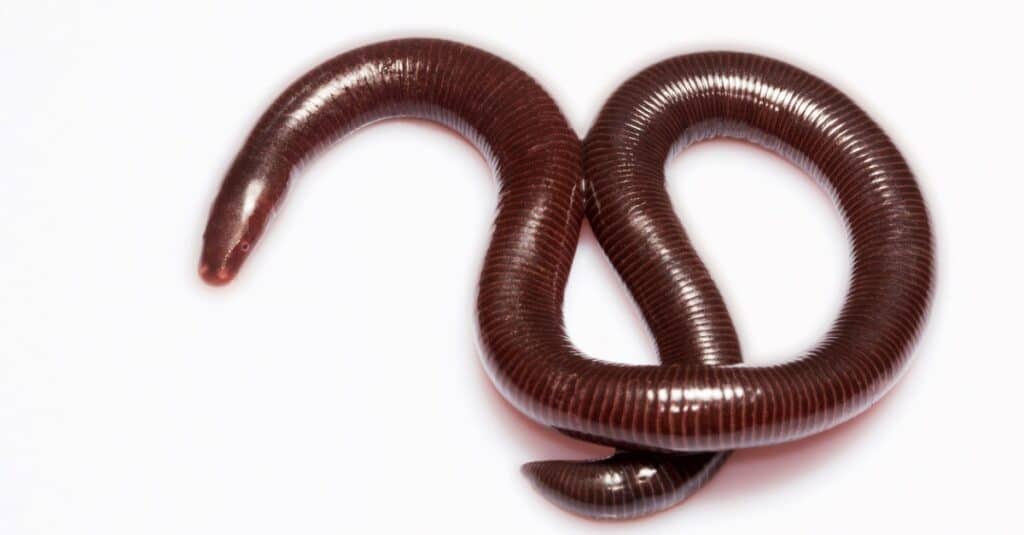
The caecilian reproductive cycle is quite unique among the animal kingdom.
©iStock.com/ePhotocorp
The reproduction and baby-rearing of caecilians are very interesting. All species of these amphibians reproduce using internal insemination. The male has a long, tube-like phallodeum used to impregnate the female. Each reproductive connection takes two to three hours before the mates separate. About one-quarter of the species are known to lay their eggs in underground dens or water. The other 75% have babies through live birth. After birth or hatching, the young of some species stay with their mother for four to six weeks.
One of the most interesting things about their reproduction and birth is how some mothers feed their young. The mothers grow thickened layers of skin. The young use hook-like or scraper-like fangs to pull at this skin, tear it away and eat it. Scientists have discovered evidence of this feeding taking place when the young of some species are still inside the mother’s womb. This activity does not harm or hurt the mother. Her skin cells are plumped up with fat during this phase, specifically to feed her young.
Some species have been seen to give birth to two to 25 live young. Others lay between 30 and 60 eggs.
Caecilians in zoos have lived for as long as 13 years. But their lifespan in the wild is not known. It is expected to vary widely by species.
Evolution
The evolutionary history of the caecilian remains shrouded in mystery for scientists. The first fossilized specimen of this creature was not found until 1972, and more fossils were not found until the 2000s. Some of these more recent discoveries unveiled that early caecilian ancestors possessed small limbs, and better-seeing eyes than their modern counterparts. This additionally led biologists to suspect that caecilians could have evolved from amniotes, a factor that their unusual reproductive traits for amphibian standards would reinforce. More theories and fossils are coming forward all the time, and scientists’ conceptions of the origins of caecilians are constantly being brought into question as more evidence arises.
Population
Of the 200+ species, the IUCN presently lists, the majority are not tracked or are listed as Least Concern or Data Deficient. But 13 species are listed as decreasing in numbers. Ten are listed as stable, three are Near Threatened, four are Vulnerable, ten are Endangered and one is Critically Endangered. That critically endangered species is the Mount Oku Caecilian of Cameroon, Africa.
Types of Caecilians
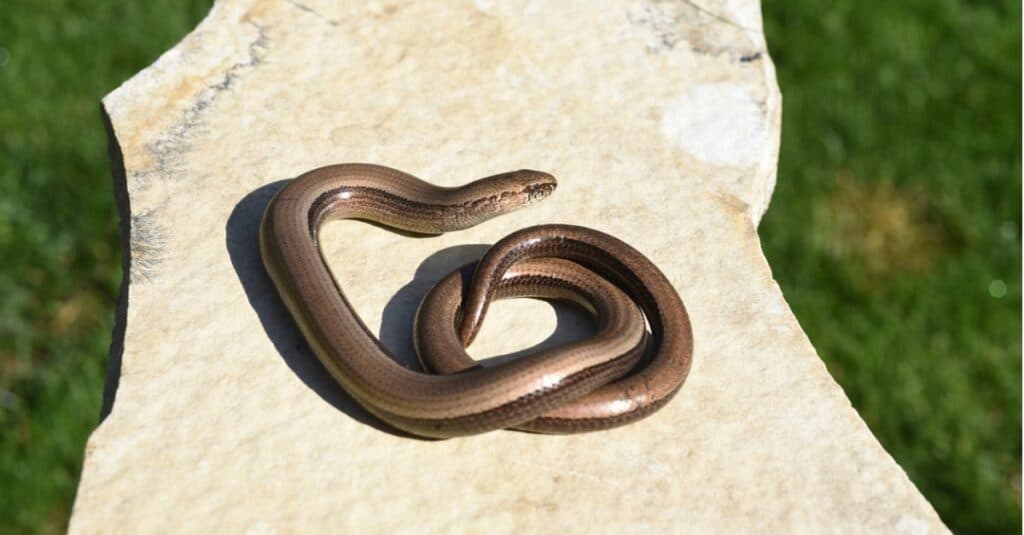
There are over 200 different types of Caecilians.
©Manfred Ruckszio/Shutterstock.com
Common Caecilians
- Caecilia abitaguae
- Caecilia albiventris
- Caecilia antioquiaensis
- Caecilia aprix
- Caecilia armata
- Caecilia atelolepis
- Caecilia attenuata
- Caecilia bokermanni
- Caecilia caribea
- Caecilia corpulenta
- Caecilia crassisquama
- Caecilia degenerata
- Caecilia disossea
- Caecilia dunni
- Caecilia epicrionopsoides
- Caecilia flavopunctata
- Caecilia goweri
- Caecilia gracilis
- Caecilia guntheri
- Caecilia inca
- Caecilia isthmica
- Caecilia leucocephala
- Caecilia macrodonta
- Caecilia marcusi
- Caecilia mertensi
- Caecilia museugoeldi
- Caecilia nigricans
- Caecilia occidentalis
- Caecilia orientalis
- Caecilia pachynema
- Caecilia perdita
- Caecilia pressula
- Caecilia pulchraserrana
- Caecilia subdermalis
- Caecilia subnigricans
- Caecilia subterminalis
- Caecilia tentaculata
- Caecilia tenuissima
- Caecilia thompsoni
- Caecilia volcani
South American Caecilians
- Oscaecilia bassleri
- Oscaecilia elongata
- Oscaecilia equatorialis
- Oscaecilia hypereumeces
- Oscaecilia koepckeorum
- Oscaecilia ochrocephala
- Oscaecilia osae
- Oscaecilia polyzona
- Oscaecilia zweifeli
Northeast Indian Caecilians
- Chikila fulleri
Neotropical Caecilians
- Dermophis costaricense
- Dermophis glandulosus
- Dermophis gracilior
- Dermophis mexicanus
- Dermophis oaxacae
- Dermophis occidentalis
- Dermophis parviceps
- Geotrypetes angeli
- Geotrypetes pseudoangeli
- Geotrypetes seraphini
- Gymnopis multiplicata
- Gymnopis syntrema
- Schistometopum ephele
- Schistometopum gregorii
- Schistometopum thomense
Indo-African Caecilians
- Gegeneophis carnosus
- Gegeneophis danieli
- Gegeneophis goaensis
- Gegeneophis krishni
- Gegeneophis madhavai
- Gegeniophis mhadeiensis
- Gegeneophis orientalis
- Gegeneophis pareshi
- Gegeneophis primus
- Gegeneophis ramaswamii
- Gegeneophis seshachari
- Gegeneophis tejaswini
- Grandisonia alternans
- Grandisonia larvata
- Grandisonia sechellensis
- Hypogeophis brevis
- Hypogeophis montanus
- Hypogeophis pti
- Hypogeophis rostratus
- Idiocranium russeli
- Indotyphlus battersbyi
- Indotyphlus maharashtraensis
- Praslinia cooperi
- Sylvacaecilia grandisonae
African Caecilians
- Boulengerula boulengeri
- Boulengerula changamwensis
- Boulengerula denhardti
- Boulengerula fischeri
- Boulengerula niedeni
- Boulengerula spawlsi
- Boulengerula taitana
- Boulengerula uluguruensis
- Herpele multiplicata
- Herpele squalostoma
Asian Tailed Caecilians
- Ichthyophis acuminatus
- Ichthyophis alfredi
- Ichthyophis asplenius
- Ichthyophis atricollaris
- Ichthyophis beddomei
- Ichthyophis bernisi
- Ichthyophis biangularis
- Ichthyophis billitonensis
- Ichthyophis bombayensis
- Ichthyophis cardamomensis
- Ichthyophis catlocensis
- Ichthyophis chaloensis
- Ichthyophis daribokensis
- Ichthyophis davidi
- Ichthyophis dulitensis
- Ichthyophis elongatus
- Ichthyophis garoensis
- Ichthyophis glandulosus
- Ichthyophis glutinosus
- Ichthyophis humphreyi
- Ichthyophis hypocyaneus
- Ichthyophis javanicus
- Ichthyophis khumhzi
- Ichthyophis kodaguensis
- Ichthyophis kohtaoensis
- Ichthyophis lakimi
- Ichthyophis laosensis
- Ichthyophis larutensis
- Ichthyophis longicephalus
- Ichthyophis mindanaoensis
- Ichthyophis monochrous
- Ichthyophis moustakius
- Ichthyophis multicolor
- Ichthyophis nguyenorum
- Ichthyophis nigroflavus
- Ichthyophis nokrekensis
- Ichthyophis orthoplicatus
- Ichthyophis paucidentulus
- Ichthyophis paucisulcus
- Ichthyophis pauli
- Ichthyophis pseudangularis
- Ichthyophis sendenyu
- Ichthyophis sikkimensis
- Ichthyophis singaporensis
- Ichthyophis sumatranus
- Ichthyophis supachaii
- Ichthyophis tricolor
- Ichthyophis weberi
- Ichthyophis youngorum
- Uraeotyphlus gansi
- Uraeotyphlus interruptus
- Uraeotyphlus malabaricus
- Uraeotyphlus menoni
- Uraeotyphlus narayani
- Uraeotyphlus oommeni
- Uraeotyphlus oxyurus
American Tailed Caecilians
- Amazops amazops
- Epicrionops bicolor
- Epicrionops columbianus
- Epicrionops lativittatus
- Epicrionops marmoratus
- Epicrionops parkeri
- Epicrionops peruvianus
- Epicrionops petersi
- Rhinatrema bivittatum
- Rhinatrema gilbertogili
- Rhinatrema nigrum
- Rhinatrema ron
- Rhinatrema shiv
- Rhinatrema uaiuai
Buried-eyed Caecilians
- Crotaphatrema bornmuelleri
- Crotaphatrema lamottei
- Crotaphatrema tchabalmbaboensis
- Scolecomorphus kirkii
- Scolecomorphus uluguruensis
- Scolecomorphus vittatus
South American Caecilians
- Brasilotyphlus braziliensis
- Brasilotyphlus dubium
- Brasilotyphlus guarantanus
- Luetkenotyphlus brasiliensis
- Luetkenotyphlus fredi
- Luetkenotyphlus insulanus
- Microcaecilia albiceps
- Microcaecilia butantan
- Microcaecilia dermatophaga
- Microcaecilia grandis
- Microcaecilia iwokramae
- Microcaecilia iyob
- Microcaecilia marvaleewakeae
- Microcaecilia nicefori
- Microcaecilia pricei
- Microcaecilia rabei
- Microcaecilia rochai
- Microcaecilia savagei
- Microcaecilia supernumeraria
- Microcaecilia taylori
- Microcaecilia trombetas
- Microcaecilia unicolor
- Mimosiphonops reinhardti
- Mimosiphonops vermiculatus
- Siphonops annulatus
- Siphonops hardyi
- Siphonops leucoderus
- Siphonops paulensis
Aquatic Caecilians
- Atretochoana eiselti
- Chthonerpeton arii
- Chthonerpeton braestrupi
- Chthonerpeton exile
- Chthonerpeton indistinctum
- Chthonerpeton noctinectes
- Chthonerpeton onorei
- Chthonerpeton perissodus
- Chthonerpeton viviparum
- Nectocaecilia petersii
- Potamotyphlus kaupii
- Typhlonectes compressicauda
- Typhlonectes natans
Caecilian FAQs (Frequently Asked Questions)
Are caecilians carnivores, herbivores, or omnivores?
These creatures are carnivores. Their diet consists mostly of earthworms, small fish, termites, insects, and other invertebrates.
What is a caecilian?
These amphibians look like an earthworm or snakes. But unlike an earthworm, they have an internal skeletal system with a backbone and skull beneath their smooth skin. Most of the 192 species live underground or in shallow streams, burrowing through the soil to find prey. Scientists still know little about these elusive creatures, such as their temperament or needs, because they are so elusive.
Where do caecilians live?
Most species live underground in wet, tropical habitats. These habitats are in South America, Central America, Asia, Southeastern Asia, Africa, and Seychelles. In the Americas, species are native to regions only as far north as Southern Mexico.
What is the sound a caecilian makes?
Like most amphibians, they do not make sounds. The creature has no vocal cords to form audible noises.
How do I pronounce caecilian?
Caecilian is pronounced “suh·si·lee·uhn.” Its name comes from the Latin word caecus, meaning “blind.”
Is Caecilian poisonous?
Caecilians are generally not poisonous. But some of the 192 known species secrete a toxic substance from their skin to dissuade predators from capturing them. Some are believed to also have venom glands behind some of their sharp teeth. Scientists believe these glands mean they can inject venom in prey, similar to venomous snake bites.
What is the difference between a caecilian and a snake?
Snakes are reptiles and caecilians are amphibians. Beyond this difference, snakes have scaly skin while caecilians have smooth skin either in segment-like rings or with calcite scales beneath the skin’s surface. These creatures actually look more like worms. But unlike worms, they have internal skeletons with backbones and a skull.
Can a caecilian be a pet?
They are not good pets. Too few facts are known about their habitats, temperament, diet, and needs for adequately caring for them. They also live beneath the ground, rarely ever visible to humans, making them less interesting than other possible pets.
Does a caecilian have jaws?
Caecilians have jaws with many sharp teeth. Their jaws also have two sets of muscles, not the one set typically found in amphibians. These muscles make their bite incredibly strong for capturing prey. They also use their strong jaws to burrow forward in the earth. One species being studied had such a strong mouth that it pushed a brick out of its way to keep burrowing forward in a lab environment.
Is a caecilian a vertebrate or invertebrate?
Caecilians are vertebrates. They have internal backbones, skulls, and jaws. They feed upon invertebrates like termites and earthworms.
Thank you for reading! Have some feedback for us? Contact the AZ Animals editorial team.
Sources
- San Diego Zoo / Accessed November 15, 2021
- Wikipedia / Accessed November 15, 2021
- National Geographic / Accessed November 15, 2021
- ScienceNewsforStudents / Accessed November 15, 2021
- Florida Museum / Accessed November 15, 2021
- Smithsonian's National Zoo / Accessed November 15, 2021
- WIRED / Accessed November 15, 2021
- San Francisco Zoo / Accessed November 15, 2021
- vertebrate diversity / Accessed November 15, 2021
- ScienceNews / Accessed November 15, 2021
- ScienceDirect / Accessed November 15, 2021
- ThoughtCo.com / Accessed November 15, 2021
- IUCN (1970) https://www.iucnredlist.org/search?query=caecilian&searchType=species Jump to top / Accessed November 15, 2021

